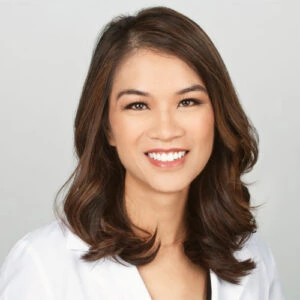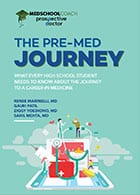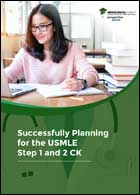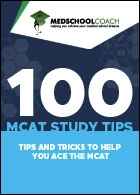
Table of Contents
If you know you want to go to medical school, it’s best to start preparing by your freshman year of high school.
Starting early on your path makes your timeline more relaxed and less stressful. It’s not difficult to make yourself competitive for an undergraduate premed program and eventually a postgraduate medical school, as long as you put in the work early.
In this simple but comprehensive guide, we’re getting into the nitty gritty of how to prepare for medical school or even a BS/MD program when you are in high school.
Plan Out Your Course Schedule
By now, you hopefully know your academic and non-academic interests, so the next step is to figure out how you will incorporate those interests into your science classes as you plan out the rest of your high school schedule.
Time management is your greatest asset when scheduling out your future. With everything you’ll need to juggle at once, future planning will reduce the unexpected and increase your productivity and effectiveness.
Learn More: What Are the Key Steps in Becoming a Doctor?
Below, I’ve listed three potential schedules. Keep in mind that the number and types of courses listed are specific to the high school I attended. Every school has different class options and scheduling structures, so only use these as templates from which you can personalize your own schedule.
| 9th Grade | 10th Grade | 11th Grade | 12th Grade |
| Biology | Chemistry Honors | AP Biology | Physics Honors |
| Geometry | Algebra 2/Trigonometry | Pre-Calculus | AP Calculus AB/BC |
| World History | AP US History | Economics | AP Government |
| American Literature | World Literature | AP Language and Composition | AP Literature |
| French I | French II | French III | French IV |
| Elective(s) | Elective(s) | Elective(s) | Elective(s) |
| 9th Grade | 10th Grade | 11th Grade | 12th Grade |
| Biology | Chemistry Honors | AP Biology | AP Chemistry |
| Algebra 2/Trigonometry | Pre-Calculus | AP Calculus AB/BC | AP Statistics |
| World History | AP U.S. History | Economics | AP Government |
| American Literature | World Literature | AP Language and Composition | Literature |
| French II | French III | French IV | Physics Honors |
| Elective(s) | Elective(s) | Elective(s) | Elective(s) |
| 9th Grade | 10th Grade | 11th Grade | 12th Grade |
| Biology | Chemistry Honors | AP Chemistry | Physics Honors |
| Pre-Calculus | AP Calculus AB/BC | AP Statistics | Multivariable Calculus |
| (No social science course) | World History | AP US History | AP Government/Economics |
| American Literature | World Literature | Language and Composition | AP Literature |
| Spanish II | Spanish III | Spanish IV Honors | AP Spanish |
| Elective(s) | Elective(s) | Elective(s) | Elective(s) |
TIP: Try to Take 6-8 AP Classes
Advanced Placement (AP) courses are high school classes that end with a special exam. If you pass this exam, you get college credit on top of your high school credit.
Taking 3 AP courses in both your junior and senior year is common, for a total of 6 AP classes. If you’re able to handle the workload without letting your grades slip, try to take 4 in one year to increase your total AP credits.
Sometimes schools allow students to take AP courses in their freshman and sophomore years, so figure out what works best in your unique situation. However, don’t overload on AP courses if it means your grades are going to slip.
I recommend taking the following three subjects as AP courses in high school: Biology, Chemistry, and Physics. A medical degree requires knowledge of all three of these science subjects.
But you can certainly take non-science APs like U.S. History or English, as long as the college credit(s) will replace your spending college credit hours in gen-eds.
Avoid taking AP Biology, AP U.S. History, and AP Language & Composition in the same semester or year, since they all require a lot of reading and theory. It’s better to replace one of those with a more applied field, such as AP Calculus.
Don’t let the process of preparing for college get overwhelming — let us walk you through it, one step at a time.
Gain Research Experience
College applicants do not need research experience; however, it can make you stand out among other students. Even 40 hours of research experience can make you a competitive premed applicant.
To be a competitive applicant for the best BS/MD programs in the country, it’s essential for you to get research experience. I recommend 100-200 hours, likely through an internship at a lab.
Reminder: BS/MD programs, AKA direct medical programs, are when you apply for an undergraduate degree and conditional acceptance to a medical program at the same time. Most people refer to them as “BS/MD,” but they may be any combination of a Bachelor’s and Medical degree (BS/MD, BS/DO, BA/MD, BA/DO). Take this quiz to determine if premed or BS/MD is right for you.
The most impressive type of research is that which students conduct at university labs. Of course, it’s not easy to get in as a high school student. If you’re unable to find lab research opportunities, conducting independent research at your high school is still impressive.
With tenacity and some guidance, it shouldn’t be too difficult to find some research experience at a university lab.
Read Next: 50+ Research Programs to Boost Your College Application
How to Find Lab Opportunities
While you’re still in high school, here are the two ways to find research opportunities in a reputable lab:
If you know anyone who works at a university lab, make your interest known to your contact. Having personal connections is really the only shortcut to getting research experience at a lab.
If you don’t have any personal connections at a lab, emailing professors is your best option. Isolate your interests instead of casting a wide net. Focus on a smaller subtopic of biology, such as neuroscience, and research in which professors work in that field.
Make a spreadsheet of professors interested in that subtopic. Research specific details of each professor’s project. Take notes on that spreadsheet by asking yourself these questions:
- What exactly is the professor researching?
- Why is it critical to understand what they’re studying?
- How do your experiences and interests match up with theirs?
Sample Email for Contacting Professors About Research Internships
You can use an email template to contact professors about your interest in research opportunities, as long as you customize the message slightly for each recipient.
Sending a well-crafted email is critical because it’s the only basis on which professors will either reject or accept you as an intern.
Use the sample email template below to give yourself a good idea of what to include in your email, plus how to structure it.
Dear Professor/Dr. ______,
My name is _____, and I am emailing to inquire about an internship for the summer of (year). I am currently a (grade level) at (high school), and for a few years now, it has been my passion to further pursue (subject) once I leave high school. Just to be clear, I am completely willing to work without pay. I’m looking to further my insights about (subject), and I believe your mentorship will be critical in helping me do so.
After reading through some of your publications, it seems your lab is focused on studying (lab objective). Your article (article name) particularly captured my attention. I would like to learn more about (topic of interest). I am currently working on an independent research project involving (subject of research), and I would like to continue to understand (ask any topic-related questions).
Being that you are an expert in this field of research, it would be an honor to have you as a mentor to help me understand and answer these, and many other, questions.
I have attached my resume and my current independent research proposal for your perusal. I genuinely believe that your assistance will be of great help to me, so I truly hope you consider me for an internship.
Thank you very much in advance for your time. Hope to hear from you soon,
(name)
Email Tip #1: Send at the Right Time
The best times to send out these cold emails for research internships are:
- September through October, after summer medical students leave and new spots open.
- December through February, when summer students are beginning to apply for positions.
Email Tip #2: Emphasize Your Interest in an Unpaid Internship
The best way to present yourself is as an intellectually curious student who is looking to gain some lab exposure and willing to work purely for experience rather than for pay.
The professors who run these labs are usually on low budgets and would most definitely not choose to spend their money on a high school student with no experience.
Email Tip #3: At Least Attempt to Read the Professor’s Publications
A lot of the content these professors publish will be too complex for you to fully wrap your head around, but you should at least attempt to read and make some sense of it. I recommend focusing on the free abstract and the conclusions, if the full article is available for free.
This crucial part of the email shows your willingness to go the extra mile for the position and that you have some idea of what you could potentially be getting involved with.
Email Tip #4: Keep It Short And Sweet
Limit the word count to around 250 words to keep the content of your email concise (but still informative).
Professors are busy people. Between all the grants they’re writing and the projects they’re supervising, they don’t have much time to read lengthy or detailed emails.
Email Tip #5: Don’t Get Discouraged & Stay Grateful
Do not be discouraged if you get negative or no responses.
When I was going through this exact process, I sent out around 200 emails and got a positive response from only 2. Most of the professors I contacted simply didn’t respond at all.
There were, however, a few that responded saying that they’d love to have me, but I was either too young or their lab was full.
Here are the best follow-up responses:
- “Thank you,” and try again next year when you’re older. University policy may require a person to be at least 16 years old to work in the lab. If you are under 16 and get a response saying you’re too young, don’t lose complete hope! You can email back saying you appreciate their response and then follow up with an email one year later.
“Thank you,” and try again in a few months when positions may free up. If you encounter the latter response (full lab), you can reply by thanking them for a response and follow up a few months later to inquire whether or not any spots have opened up.
Start Volunteering
Applying to a traditional liberal arts undergraduate school does not require volunteering hours. However, volunteering on your resume — especially in a health-related setting — will make you more competitive.
Direct medical programs (BS/MD or BS/DO) are looking for students who have already been committed to the field of medicine for years before they apply to college.
Whether for a BS/MD or a pre-med program, I’ve listed below the easiest and most common volunteering opportunities where you can show interest in and dedication to the field of medicine:
- Local hospital
- Hospice home
- Private practice
- Local non-profit that deals with public healthcare, reaching underserved communities, etc.
These unpaid volunteer activities are not just resume boosters and heart warmers. These opportunities will give you a glimpse into your future as a physician, helping you figure out whether medicine is really the right field for you.
Speaking from a personal perspective, I can tell you that volunteering at a children’s hospice was one of the most difficult yet also one of the most valuable experiences of my high school career. It taught me to face arguably the worst part of becoming a doctor: the reality of death.
But in learning to deal with that, I also gained a newfound appreciation for life, which only further affirmed within me the thought that waking up and working to better someone’s health every day is something I can envision myself doing for the rest of my life.
Quick Link: Best Clinical Shadowing
Ace the SAT or ACT
Complete the SAT/ACT as soon as possible to free up your time for volunteering, internships, keeping your GPA high, applying for college, and maintaining a healthy social life.
You only need to take one of these tests, either the Scholastic Aptitude Test (SAT) or the American College Testing (ACT). There is no huge difference in taking one over the other, but here are the benefits of each standardized test.
Choose the SAT if:
- You prefer a little more time to answer questions.
- You’re stronger in algebra and reading comprehension.
- You’re weaker with science-related graph reading.
Choose the ACT if:
- You work well under tight time limits.
- You like shorter, more direct questions.
- You’re strong in geometry, trigonometry, and graph interpretation.
Most students take these standardized tests in their junior year. However, between your sophomore year and junior year, one class won’t suddenly prepare you to master the SAT or ACT.
I recommend taking the test in your sophomore year or the beginning of junior year. Give yourself time to retake the test in case you’re unhappy with your score. Aim for top 10% scores: 1450+ out of 1600 for the SAT and 32+ out of 36 for the ACT.
My secret to mastering these standardized tests: learning the best test-taking strategies and study habits, and practicing them over and over and over again.
Read More: SAT Strategies | ACT Strategies
Breeze Through the College Application Process
In the summer before your high school senior year, start working on your college applications and essays. It’s helpful to decide on your major during this process. (Pre-med is not a major, but you may be able to follow a pre-med track to ensure you get the right prerequisites.)
Download this free, comprehensive guide for high schoolers planning on going to premed and then med school.
Choose your safe schools, reach schools, and backup schools based on your grades, goals, cost, location, and other factors that are important to you. I recommend making a spreadsheet that includes application deadlines, unique requirements, and how much you want to attend each school.
Start working on your college essays early. Here are my top tips for writing undergraduate, premed college essays:
- I recommend starting with your largest prompts since those are going to be the ones that take the most time.
- I encourage writing multiple prompts at the same time (whether the big one and a few small ones or multiple big ones) simply because it minimizes the chances of feeling stuck.
- I suggest you use essay templates as inspiration, but avoid plagiarizing, copying, or forgetting to customize your essays for the school you’re applying to.
For BS/MD applicants, you will write nearly twice as many essays as traditional college applicants, so my best advice is to start writing even earlier than the summer after junior year.
Learn More: Personal Statement Writing Guide for Med School & BS/MD
Prepare for Interviews
Not all colleges require college interviews. Major institutions are more likely to have them, and any direct medical programs (undergrad and medical education alongside one another) will certainly have them.
College interviews typically occur from November to March, with non-early decision applicants primarily interviewing in January and February. For BS/MD programs, the interview schedule will likely be similar.
Here are just a few handy tips for interview prep:
- If you’re applying to BS/MD programs, get ready for some travel. A lot of programs may require you to interview on the medical school or university campus. If you’re going out of town overnight, research nearby hotels or motels. Feel free to explore the town when you’re not on campus.
- If you’re only applying to undergrad programs, chances are you won’t have to travel too far. Many schools offer virtual interviews or will connect you with a local alumnus who will conduct the interview. Some allow you to schedule interviews on-campus if you happen to be visiting.
- Dress professionally and comfortably. For women, wear a dress or dress pants, and for men, wear a suit jacket and a button-up. Stick with neutral colors like gray, black, white, brown, and blue.
- Come prepared with questions you can ask the interviewers. For instance, “Where do you hope to see your alumni 5-10 years after graduation?”
- Practice honest answers to common questions. They’re almost certainly going to ask you what your strengths are, hobbies, and perhaps what makes you unique.
- Make eye contact. Try not to shift nervously. Be yourself, and remember these are human beings you’re talking to.
- Get the um’s out of your lexicon. Don’t stress out about getting this one perfect, but practice not letting yourself say filler words like “um,” “er,” and “like” in the months leading up to your interview. Get comfortable ending a sentence and starting a new one. Be okay with a slight, silent pause while you gather your thoughts.
Read Next: What Are the Best Pre-Med Schools?
FAQs
BS/MD programs are competitive by design. While in undergrad, you’ll be doing the same work as any other student on a pre-med track, but you’ll need to maintain very high scores to qualify for your granted conditional acceptance to medical school.
So, in other words, you’ll be just as busy as your classmates preparing to apply to medical school, but with a bit more pressure to achieve high scores and grades. However, some BS/MD programs waive the MCAT requirement for med school to make up for this rigorous expectation (though this is less common than it used to be).
As with any pre-med, you’ll also need to work towards gaining research and clinical experience, shadowing hours, and other extracurricular activities required for medical school admissions.
In general, a GPA of 3.4 or above is ideal to get into a premed program, depending on the institution. A killer college essay, letter of recommendation, or resume including volunteer work can strengthen your application if your high school GPA is on the low side.
No, you generally cannot get into medical school without an MCAT score. The exception (sort of) is for students in a few direct medical (B/MD or B/DO) programs or early assurance programs. As of 2025, there are 15 direct medical programs and 12 EAPs in the US that waive the MCAT requirement.
Students applying for BS/MD or BS/DO programs are never required to take the MCAT to apply (17- or 18-year-olds would never be expected to have this knowledge before undergrad).
A few BS/MD or BS/DO programs don’t require enrolled students to take the MCAT before finalizing their med school acceptance. This is pretty uncommon, though. In many cases, direct medical programs still require their students to take the MCAT in their second or third year of college, even if there’s no minimum score they are expected to meet.
In undergraduate and medical school admissions, some schools offer early decision or early action application programs.
Generally speaking, early decision is when you make an ethically-binding “contract” with a school that, if they offer you a spot early, you’ll accept it, not applying anywhere else. If there’s no offer, they’ll typically release you from this ethical contract early enough to apply elsewhere.
Early action is not binding, but it is also less advantageous. It’s simply about applying early and getting a decision early. There’s no downside, really.
Note: Some schools use “early action” to refer to the binding ethical contract that typically is reserved for the term “early decision.”
Get Multi-Year Support With Pre-Med Coach
Applying to colleges with medical school on the horizon can be overwhelming, but by reading this, you’re already more prepared than most! MedSchoolCoach doesn’t only offer free guides — we also have Physician Advisors standing by, ready to help you along your journey.
As long as you really take the time to plan everything out, you’ll be right on track for premed-to-medical school or BS/MD success.
Ready to start your journey to become a physician? MedSchoolCoach has dedicated Physician Advisors who have successfully gone through high school all the way through med school themselves. They can help you plan years in advance.

Kachiu Lee, MD
Dr. Lee specializes in BS/MD admissions. She was accepted into seven combined bachelor-medical degree programs. She graduated Summa Cum Laude from Northwestern University and proceeded to Northwestern University’s Feinberg School of Medicine in Chicago, IL. After completing a dermatology residency at Brown University, Dr. Lee pursued a fellowship in Photomedicine, Lasers, and Cosmetics at Massachusetts General Hospital and was a Clinical Fellow at Harvard Medical School. Academically, she has over 100 peer-reviewed publications and lectures internationally.





